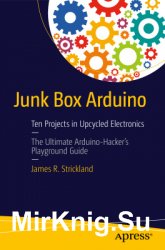
Название: Junk Box Arduino: Ten Projects in Upcycled Electronics
Автор: Strickland James R.
Издательство: Apress
Год: 2016
Формат: pdf
Страниц: 432
Размер: 9 Мб
Язык: английский
We all hate to throw electronics away. Use your 5 volt Arduino and have fun with them instead! Raid your electronics junk box to build the Cestino (Arduino compatible) board and nine other electronics projects, from a logic probe to a microprocessor explorer, and learn some advanced, old-school techniques along the way. Don't have a well-stocked junk box? No problem. Nearly all the components used in these projects are still available (and cheap) at major electronic parts houses worldwide.
Junk Box Arduino is the ultimate have-fun-while-challenging-your-skills guide for Arduino hackers who've gone beyond the basic tutorials and are ready for adventures in electronics. Bonus materials include all the example sketches, the Cestino core and bootloader source code, and links to suppliers for parts and tools.
Bonus materials include extensions to the Cestino, Sourceforge links for updated code, and all the source-code for the projects.
What you’ll learn:
How to build the Cestino (it means recycle bin), and learn how Arduino compatibles actually work, and how to make your own.
All about eight bit ports and binary logic building the Larson (Memorial) Scanner.
How transistors really work, and how to use them without frying them as you build and use the transistor analyzer.
See what the ubiquitous 7400 series logic chips actually do with the TTL (Transistor-Transistor Logic) chip tester you’ll build.
That high logic levels do not always equal true because you can see them when you build a simple logic probe.
How to interface EPROM and EEPROM/FLASH memory as you explore the contents of that old video game or BIOS EPROM.
How ATA drives communicate by resurrecting that old PATA drive you kept from 10 years ago.
How to build a role playing game dice roller with a two digit, 7 segment display and learn to use Arduino interrupts for pin multiplexing.
How computers really work by connecting a Z80 microprocessor to memory and peripherals simulated by your Cestino. You’ll even learn a little assembly language.
Who this book is for:
Much of the current Arduino resource-publishing effort focuses on beginners, and beginning-level projects: flashing LEDs, connecting simple sensors, combining shields (Arduino plugin boards) and so on. The audience for this book are people who are ready to go one step further, into more complex and powerful projects.